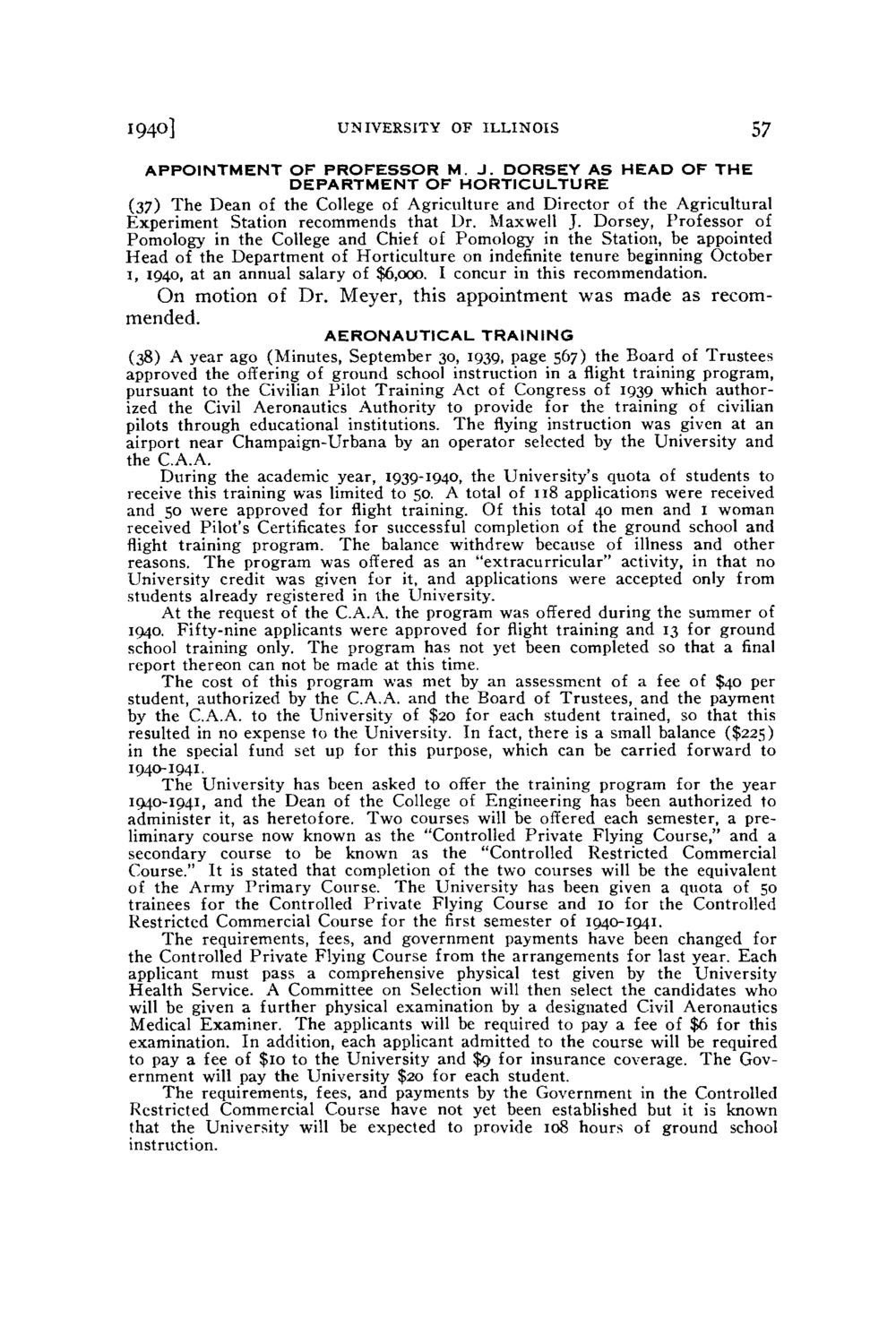| |
| |
Caption: Board of Trustees Minutes - 1942
This is a reduced-resolution page image for fast online browsing.

EXTRACTED TEXT FROM PAGE:
i94»] UNIVERSITY OF ILLINOIS 57 APPOINTMENT OF PROFESSOR M . J . DORSEY AS HEAD OF THE DEPARTMENT OF HORTICULTURE (37) T h e Dean of the College of Agriculture and Director of the Agricultural Experiment Station recommends that Dr. Maxwell J. Dorsey, Professor of Pomology in the College and Chief of Pomology in the Station, be appointed H e a d of the Department of Horticulture on indefinite tenure beginning October I, 1940, at an annual salary of $6,000. I concur in this recommendation. O n m o t i o n of D r . M e y e r , t h i s a p p o i n t m e n t w a s m a d e a s r e c o m mended. AERONAUTICAL TRAINING (38) A year ago (Minutes, September 30, 1939, page 567) the Board of Trustees approved the offering of ground school instruction in a flight training program, pursuant to the Civilian Pilot Training Act of Congress of 1939 which authorized the Civil Aeronautics Authority to provide for the training of civilian pilots through educational institutions. T h e flying instruction was given at an airport near Champaign-Urbana by an operator selected by the University and the C.A.A. During the academic year, 1939-1940, the University's quota of students to receive this training was limited to 50. A total of 118 applications were received and 50 were approved for flight training. Of this total 40 men and I woman received Pilot's Certificates for successful completion of the ground school and flight training program. The balance withdrew because of illness and other reasons. T h e program was offered as an "extracurricular" activity, in that no University credit was given for it, and applications were accepted only from students already registered in the University. At the request of the C.A.A. the program was offered during the summer of 1940. Fifty-nine applicants were approved for flight training and 13 for ground school training only. T h e program has not yet been completed so that a final report thereon can not be made at this time. T h e cost of this program was met by an assessment of a fee of $40 per student, authorized by the C.A.A. and the Board of Trustees, and the payment by the C.A.A. to the University of $20 for each student trained, so that this resulted in no expense to the University. In fact, there is a small balance ($225) in the special fund set up for this purpose, which can be carried forward to 1940-1941. T h e University has been asked to offer the training program for the year 1040-1941, and the Dean of the College of Engineering has been authorized to administer it, as heretofore. Two courses will be offered each semester, a preliminary course now known as the "Controlled Private Flying Course," and a secondary course to be known as the "Controlled Restricted Commercial Course." It is stated that completion of the two courses will be the equivalent of the Army P r i m a r y Course. T h e University has been given a quota of 50 trainees for the Controlled Private Flying Course and 10 for the Controlled Restricted Commercial Course for the first semester of 1940-1941. T h e requirements, fees, and government payments have been changed for the Controlled Private Flying Course from the arrangements for last year. Each applicant must pass a comprehensive physical test given by the University Health Service. A Committee on Selection will then select the candidates who will be given a further physical examination by a designated Civil Aeronautics Medical Examiner. The applicants will be required to pay a fee of $6 for this examination. In addition, each applicant admitted to the course will be required to pay a fee of $10 to the University and $9 for insurance coverage. T h e Government will pay the University $20 for each student. The requirements, fees, and payments by the Government in the Controlled Restricted Commercial Course have not yet been established but it is known that the University will be expected to provide 108 hours of ground school instruction.
| |